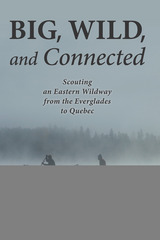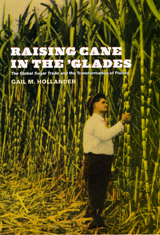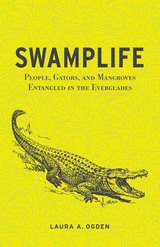3 books about Everglades

Big, Wild, and Connected
Scouting an Eastern Wildway from the Everglades to Quebec
John Davis
Island Press, 2015
In 2011, adventurer and conservationist John Davis walked, cycled, skied, canoed, and kayaked on an epic 10-month, 7,600-mile journey that took him from the keys of Florida to a remote seashore in northeastern Quebec. Davis was motivated by a dream: to see a continent-long corridor conserved for wildlife in the eastern United States, especially for the large carnivores so critical to the health of the land.
In Big, Wild, and Connected, we travel the Eastern Wildway with Davis, viscerally experiencing the challenges large carnivores, with their need for vast territories, face in an ongoing search for food, water, shelter, and mates. On his self-propelled journey, Davis explores the wetlands, forests, and peaks that are the last strongholds for wildlife in the East. This includes strategically important segments of disturbed landscapes, from longleaf pine savanna in the Florida Panhandle to road-latticed woods of Pennsylvania. Despite the challenges, Davis argues that creation of an Eastern Wildway is within our reach and would serve as a powerful symbol of our natural and cultural heritage.
Big, Wild, and Connected reveals Eastern landscapes through wild eyes, a reminder that, for the creatures with which we share the land, movement is as essential to life as air, water, and food. Davis’ journey shows that a big, wild, and connected network of untamed places is the surest way to ensure wildlife survival through the coming centuries.
In Big, Wild, and Connected, we travel the Eastern Wildway with Davis, viscerally experiencing the challenges large carnivores, with their need for vast territories, face in an ongoing search for food, water, shelter, and mates. On his self-propelled journey, Davis explores the wetlands, forests, and peaks that are the last strongholds for wildlife in the East. This includes strategically important segments of disturbed landscapes, from longleaf pine savanna in the Florida Panhandle to road-latticed woods of Pennsylvania. Despite the challenges, Davis argues that creation of an Eastern Wildway is within our reach and would serve as a powerful symbol of our natural and cultural heritage.
Big, Wild, and Connected reveals Eastern landscapes through wild eyes, a reminder that, for the creatures with which we share the land, movement is as essential to life as air, water, and food. Davis’ journey shows that a big, wild, and connected network of untamed places is the surest way to ensure wildlife survival through the coming centuries.
[more]

Raising Cane in the 'Glades
The Global Sugar Trade and the Transformation of Florida
Gail M. Hollander
University of Chicago Press, 2008
Over the last century, the Everglades underwent a metaphorical and ecological transition from impenetrable swamp to endangered wetland. At the heart of this transformation lies the Florida sugar industry, which by the 1990s was at the center of the political storm over the multi-billion dollar ecological “restoration” of the Everglades. Raising Cane in the ’Glades is the first study to situate the environmental transformation of the Everglades within the economic and historical geography of global sugar production and trade.
Using, among other sources, interviews, government and corporate documents, and recently declassified U.S. State Department memoranda, Gail M. Hollander demonstrates that the development of Florida’s sugar region was the outcome of pitched battles reaching the highest political offices in the U.S. and in countries around the world, especially Cuba—which emerges in her narrative as a model, a competitor, and the regional “other” to Florida’s “self.” Spanning the period from the age of empire to the era of globalization, the book shows how the “sugar question”—a label nineteenth-century economists coined for intense international debates on sugar production and trade—emerges repeatedly in new guises. Hollander uses the sugar question as a thread to stitch together past and present, local and global, in explaining Everglades transformation.
Using, among other sources, interviews, government and corporate documents, and recently declassified U.S. State Department memoranda, Gail M. Hollander demonstrates that the development of Florida’s sugar region was the outcome of pitched battles reaching the highest political offices in the U.S. and in countries around the world, especially Cuba—which emerges in her narrative as a model, a competitor, and the regional “other” to Florida’s “self.” Spanning the period from the age of empire to the era of globalization, the book shows how the “sugar question”—a label nineteenth-century economists coined for intense international debates on sugar production and trade—emerges repeatedly in new guises. Hollander uses the sugar question as a thread to stitch together past and present, local and global, in explaining Everglades transformation.
[more]

Swamplife
People, Gators, and Mangroves Entangled in the Everglades
Laura A. Ogden
University of Minnesota Press, 2010
Little in North America is wilder than the Florida Everglades—a landscape of frightening reptiles, exotic plants in profusion, swarms of mosquitoes, and unforgiving heat. And yet, even from the early days of taming the wilderness with clearing and drainage, the Everglades has been considered fragile, unique, and in need of restorative interventions. Drawing on a decade of fieldwork with hunters in the Everglades, Laura A. Ogden explores the lives and labors of people, animals, and plants in this most delicate and tenacious ecosystem.
Today, the many visions of the Everglades—protectionist, ecological, commercial, historical—have become a tangled web of contradictory practices and politics for conservation and for development. Yet within this entanglement, the place of people remains highly ambivalent. It is the role of people in the Everglades that interests Ogden, as she seeks to reclaim the landscape’s long history as a place of human activity and, in doing so, discover what it means to be human through changing relations with other animals and plant life.
Ogden tells this story through the lives of poor rural whites, gladesmen, epitomized in tales of the Everglades’ most famous outlaws, the Ashley Gang. With such legends and lore on one side, and outsized efforts at drainage and development on the other, Swamplife strikes a rare balance, offering a unique insight into the hidden life of the Everglades—and into how an appreciation of oppositional culture and social class operates in our understanding of wilderness in the United States.
[more]
READERS
Browse our collection.
PUBLISHERS
See BiblioVault's publisher services.
STUDENT SERVICES
Files for college accessibility offices.
UChicago Accessibility Resources
home | accessibility | search | about | contact us
BiblioVault ® 2001 - 2024
The University of Chicago Press









